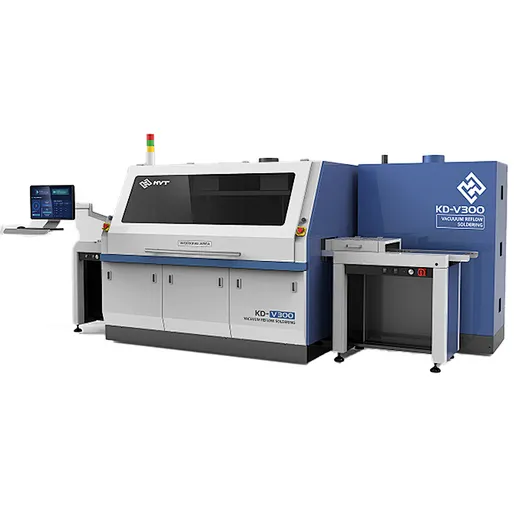Through-hole reflow soldering is a variation of traditional through-hole soldering that combines the advantages of both through-hole and surface mount soldering processes. In this method, components with through-hole leads are inserted into the PCB as usual. However, instead of relying solely on wave soldering or manual soldering techniques, the assembly undergoes a reflow soldering process, similar to that used in surface mount technology (SMT).
During through-hole reflow soldering, solder paste is applied to the through-hole component leads and the PCB pads. The assembly is then subjected to a reflow oven, where controlled heating melts the solder paste, forming reliable solder joints between the component leads and the PCB pads. The surface tension of the molten solder helps to precisely align and secure the components in place, ensuring optimal electrical and mechanical connections.
Through-hole reflow soldering offers several advantages over traditional through-hole soldering methods. It simplifies the assembly process by eliminating the need for additional wave soldering equipment, reducing the risk of thermal shock to sensitive components, and enabling the simultaneous soldering of both through-hole and surface mount components on the same PCB. Additionally, it allows for tighter component spacing and increased design flexibility, making it suitable for applications where space constraints are a concern.
Reflow Soldering
Reflow soldering is a widely used soldering technique in electronics manufacturing, particularly in surface mount technology (SMT) assembly. This process involves attaching electronic components to a printed circuit board (PCB) by melting solder paste that has been applied to the board's surface.
Here's how reflow soldering typically works:
- Application of Solder Paste: A stencil is used to precisely apply solder paste to the solder pads on the PCB. The solder paste is a mixture of tiny solder particles suspended in flux, which helps clean the metal surfaces and promotes solder wetting.
- Component Placement: Surface mount components (SMDs) are then accurately placed onto the solder paste on the PCB. This step can be performed manually or using automated pick-and-place machines, depending on the scale of production.
- Reflow Process: The assembled PCB undergoes a reflow process, where it is heated in a controlled manner using a reflow oven or conveyor belt system. As the temperature rises, the solder paste liquefies, creating solder joints between the component leads and the PCB pads. The reflow process typically consists of several stages, including preheating, temperature ramp-up, soaking, reflow, and cooling.
- Inspection and Quality Control: Once the reflow process is complete, the solder joints are inspected to ensure they meet the required quality standards. This may involve visual inspection, X-ray inspection, or automated optical inspection (AOI) systems.
Reflow soldering offers several advantages over traditional soldering methods, including:
- High precision and repeatability: Solder paste application and component placement can be accurately controlled, resulting in consistent solder joint quality.
- High throughput: Reflow soldering is well-suited for automated assembly processes, allowing for high-volume production with minimal manual intervention.
- Reduced solder bridging and defects: The controlled heating during reflow helps minimize solder bridging, tombstoning, and other common soldering defects.
- Compatibility with miniaturized components: Reflow soldering enables the assembly of small and densely packed SMDs, making it ideal for modern electronics with compact designs.
Key Differences
The main differences between through-hole reflow soldering and traditional reflow soldering are as follows:
1.Process Flow
Through-hole reflow soldering can simultaneously solder through-hole components and surface-mount components in a single step, simplifying the process and eliminating the need for wave soldering. Traditional reflow soldering is mainly used for surface mount devices, with the connection achieved by melting the paste solder pre-spread on the PCB pads.
2.Equipment, Material, and Labor Requirements
Through-hole reflow requires fewer equipment, materials, and manpower, helping to reduce production costs and shorten production cycles. Traditional reflow soldering demands more equipment, materials, steps, and personnel.
3.Throughput and Reliability
Through-hole reflow soldering can reduce the high defect rate caused by wave soldering and achieve a high through-hole reflow soldering rate. Traditional reflow soldering may not match through-hole reflow soldering in terms of throughput rate and reliability.
4.Applicability and Limitations
Through-hole reflow soldering is suitable for various component types, including through-hole components and surface-mount components. However, some through-hole components may not be mountable due to factors such as inherent strength, reliability, and serviceability. Traditional reflow soldering is mainly suitable for surface mount devices and may not provide sufficient mechanical strength for larger board sizes and insufficient flatness.
5.Temperature Curve and Preheating Section
Through-hole reflow soldering requires establishing a suitable temperature profile to ensure that the solder paste in the through-hole and the component pins have an appropriate reflow soldering temperature profile. Traditional reflow soldering also requires consideration of the temperature profile and preheating section to ensure soldering quality and avoid component damage from thermal shock.
In summary, through-hole reflow soldering combines the advantages of traditional reflow soldering, simplifies the process, reduces equipment and material requirements, and enhances throughput rate and reliability. However, it also has its applicability and limitations, requiring adjustments and optimizations according to specific conditions in practical applications.
Applications and Considerations
Through-hole reflow soldering finds applications in scenarios demanding robust mechanical connections, such as automotive, aerospace, and industrial electronics. Conversely, reflow soldering excels in high-volume production environments, offering unparalleled efficiency and scalability in consumer electronics, telecommunications, and IoT devices.
In conclusion, both through-hole reflow soldering and reflow soldering serve as indispensable tools in the electronics manufacturing arsenal, each with its distinct advantages and applications. By understanding the nuances of these soldering techniques, manufacturers can make informed decisions to optimize their production processes and achieve superior product quality.
Whether you're a seasoned professional or an electronics enthusiast embarking on DIY projects, mastering the intricacies of through-hole reflow soldering and reflow soldering opens doors to endless possibilities in the ever-evolving world of electronics assembly.

Comments